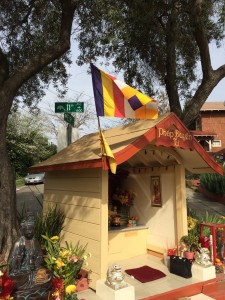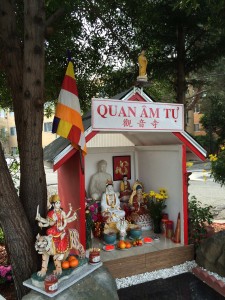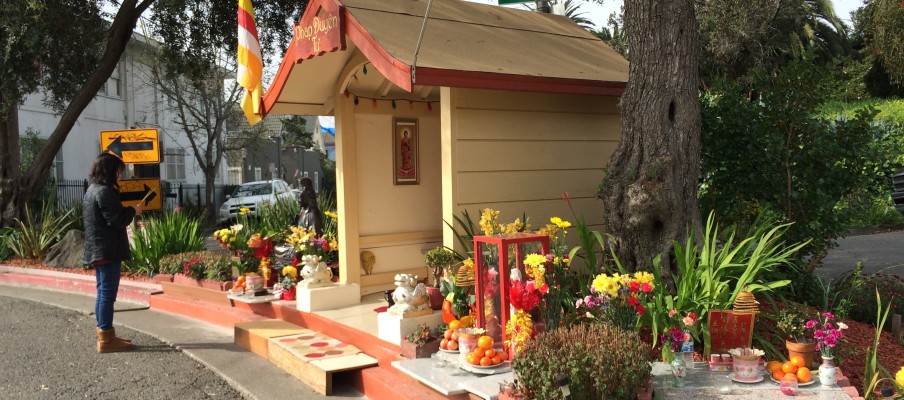Several months ago, I became aware of a Buddhist shrine that had been built on a street corner in the Clinton neighborhood of Oakland. This morning, I finally had a chance to visit it myself and take some pictures.
 The first news item I found about this place tells the basic story: a local resident was frustrated by the corner attracting illegal dumping, graffiti, and the usual array urban problems. So he bought a stone Buddha statue from an Ace hardware store, stuck it on the corner, and let it be. In pretty short order, local Vietnamese Buddhists not only started leaving the statue offerings of fruit, flowers, and incense, but they built a whole shrine around it. The city tried to remove it; the neighbors fought the city and got a permit for it; and by all accounts crime and blight have dropped around the site.
The first news item I found about this place tells the basic story: a local resident was frustrated by the corner attracting illegal dumping, graffiti, and the usual array urban problems. So he bought a stone Buddha statue from an Ace hardware store, stuck it on the corner, and let it be. In pretty short order, local Vietnamese Buddhists not only started leaving the statue offerings of fruit, flowers, and incense, but they built a whole shrine around it. The city tried to remove it; the neighbors fought the city and got a permit for it; and by all accounts crime and blight have dropped around the site.
I’ve since found links to other articles and blog posts that tell the same general narrative. And it’s a good one. It’s nice to know that, if nothing else, the folks in the neighborhood respect the shrine enough to leave it be.
When I got there this morning, around 11 o’clock, the neighborhood was pretty quiet, and the shrine looked much like it does in the pictures I’ve seen around the web. However, what internet pictures can’t do justice to is the full range of sensory experiences of being there. Yes, there’s the smell of incense. But there’s also music. In addition to statues and shrines and offerings, they have installed two small, battery powered audio boxes (that look not unlike the Buddha Machine) that play chants accompanied by music on a loop. The chants are devotions to Amitabha.
After being there for no more than five minutes, a woman about my age walked up with a bag full of small oranges. She struck up a conversation with me about how I’d heard about the shrine, what my interest was, and without my asking telling me its story. A lot of this story was what I’d already read online. But it was very nice to have a local informant, as it were, verify things for me. She went about her routine, placing oranges at each of the small shrines around the main one — two for different aspect of Quan Yin, one around the side, and the main one inside the shelter. She also took some incense, lit it from the votive candle, and offered it to each shrine. This routine was punctuated by her telling me about how people had added to the shrine over the years, how they pray to it for benefits — “they believe good things will happen, that there’s good energy,” she said — and how she comes to the shrine almost every morning. I asked her if she lived in the area, or if there was a nearby temple that helped with the shrine. I’m not sure she understood my question; she told me there are lots of temples all over, and mentioned one specifically in Fremont or Hayward.
 She then proceeded to tell me about another shrine a couple blocks away. She told me that another man had tried to add an additional statue to the first shrine, but it was Chinese — “which is a different culture,” she said — and so he built a different shrine. I want to more about these two different shrines, their origin stories, and their connections to different local Buddhist communities. My informant was very kind and gracious, but I don’t speak Vietnamese, so there was a gap between us. A lot was left unsaid.
She then proceeded to tell me about another shrine a couple blocks away. She told me that another man had tried to add an additional statue to the first shrine, but it was Chinese — “which is a different culture,” she said — and so he built a different shrine. I want to more about these two different shrines, their origin stories, and their connections to different local Buddhist communities. My informant was very kind and gracious, but I don’t speak Vietnamese, so there was a gap between us. A lot was left unsaid.
She left not long after that, and I did, too, determined to find this other shrine. It wasn’t hard, of course, only a block or two away. Despite her comment about the Chinese statue, this other shrine is also named in both Chinese and Vietnamese. Nevertheless, it does seem to have more of an explicitly Chinese sensibility to it. But here I’m venturing out of my league. I can find my way around most Japanese Buddhist altars pretty well; these shrines are familiar in many ways, but they are still unfamiliar territory.
So I’m left wondering about some of the details — what’s the history and untold stories between these shrines? what are the ancillary shrines devoted to? benefactors? ancestors? I am also left with an appreciation for religion as practice. The narrative about a Buddha statue bringing change to urban blight is nice and all; but let’s be honest. These two shrines, while certainly having an impact on their immediate surroundings, have done nothing to curb deeper and systemic political and economic inequality in Oakland. Their good energy is not having much of an impact on larger issues of discrimination and poverty. But that’s another story, another narrative to be told.
As much as those larger socio-economic issues need to be addressed, I am also left thinking about how these sites inspire a specific type of devotion and practice, a type of practice that we generally don’t talk about in “American Buddhism,” obsessed as we are with mindfulness, with meditation, with he pioneers and trailblazers, with the geeks and other shiny new things who seek to re-make Buddhism in our own image. Here, there’s something quieter happening, something involving families and women and locals and non-Buddhists. Something no less meaningful and important to the larger narrative about Buddhism in these United States. It matters to this woman who brings oranges every day. It matters to the people who clean it and care for it. It serves some purpose in their lives, and I think we would do well to recognize and respect that.
There’s more to say, I’m sure. For now I wanted to get these initial thoughts and reflections down before they got lost in the rest of my day.


Leave a Reply